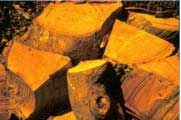|
|
|
Fuelwood and extractives

Although the greatest use of timber internationally
is as fuel, growing wood fuel for profit remains a specialised
business. The largest market for wood fuel is for domestic
heating with the highest prices paid in urban areas, particularly
Canberra, Adelaide and Melbourne. Although market preferences
may sometimes be based on misconceptions, such as the belief
that eucalypts with red coloured wood are better, there are
some important product specifications that can influence market
demand and price.
Although wood can be an efficient and clean source of heat
energy, satisfactory combustion is dependent on the moisture
content. The moisture content of freshly cut green timber
can be well over 100 per cent (meaning there may be more water
than wood in the log). If left to dry, the wood will eventually
reach equilibrium moisture content with the environment that
may be between 10 and 20 per cent. The calorific value of
green wood, with a moisture content of 100 per cent, is about
half that of the same wood dried to a moisture content of
20 per cent.
The calorific value of the dense eucalypt hardwoods is actually
slight less that that of low density pine (19 kJ/g compared
to 21 kJ/g when oven dried). However, because the difference
is small, density remains an important feature, particularly
when fuel is sold by volume. Premium prices are often only
paid for dense dry wood. Because the density of eucalypt timber
varies with age young plantations might provide fuel wood
with 20–30 per cent less density than mature trees of
the same species. Growers must be cautious when calculating
the value of their forest for fuel wood based on a volume
assessment alone.
Other important burning properties are the combustion rate
—faster means hotter; and the presence of resins or other
extractives—these can cause spitting and smouldering
or create soot problems.
The cost of processing and retailing is the major problem
associated with growing wood for fuel. Before reaching the
market the timber needs to be felled, cut to length, split,
stacked, dried, loaded and transported. Plantation designs
and management techniques that reduce pre-sale processing
costs will improve returns.
Before planting a farm forest to supply wood for fuel, farmers
need to be aware that the market for high value firewood is
uncertain—now and in the future. In some Australian cities,
state and local governments are introducing incentives and
penalties to discourage the burning of wood for home heating.
Farmers thinking about growing timber for the valuable urban
markets should consider the effect of future local government
or environmental protection authority controls on the use
of wood heaters and open fireplaces.
Back to top
 |
|
|
|
